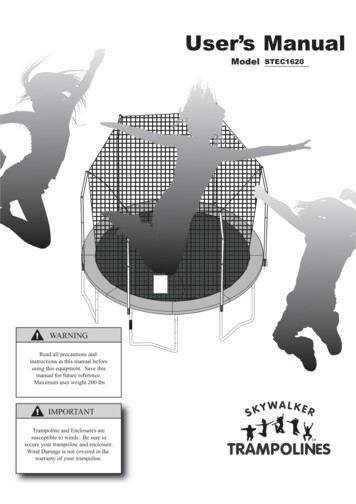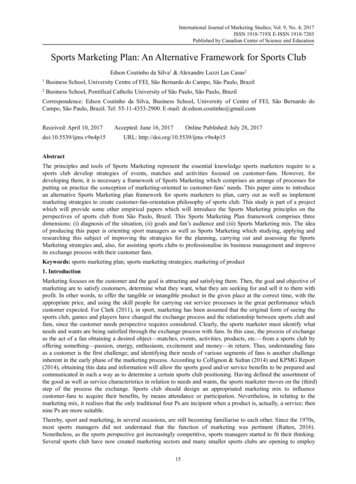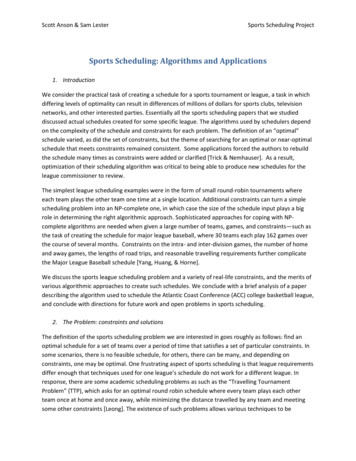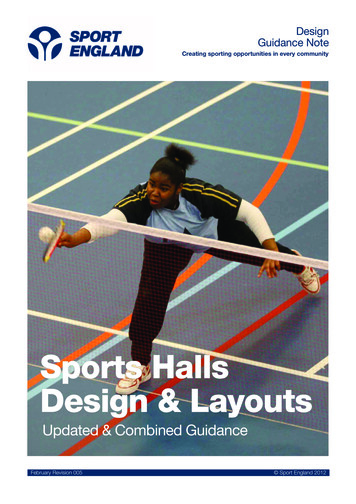
Transcription
User’s ManualSTEC1620ModelWARNINGRead all precautions andinstructions in this manual beforeusing this equipment. Save thismanual for future reference.Maximum user weight 200 lbsIMPORTANTTrampoline and Enclosures aresusceptible to winds. Be sure tosecure your trampoline and enclosure.Wind Damage is not covered in thewarranty of your trampoline
ModelSTEC1620A serial decal is found on one of the trampoline legs. Model number decal tag is located on the jumping mat.CONTENTSImportant Precautions.3Warning Label Placement.4Before You Begin.4Trampoline Safety Information.5Enclosure Safety Information.6Methods of Accident Prevention.7Use and Instructional Material.8Use and Instructional Material.9Instructional Program and Model Lessons .10Basic Trampoline skills.11-12Assembly.13-20Care and Maintenance.21Exploded Drawing and Parts List.22-23Ordering Replacement Parts.23Limited Warranty.24QUESTIONS?If you have questions after reading this manual, please call our toll-free Customer Care Hot Line. The trained technicianson our Customer Care Hot Line will provide immediate assistance.Customer Care Hot Line: 1-866-603-Jump(5867)Monday—Friday, 8a.m.—5p.m. MountainTimeREPLACEMENT PARTSwww.skywalkertrampolines.comWARNINGRead the assembly, installation, care, maintenance, and use instructions in this manual prior to assembling andusing this trampoline. Save this manual for future reference.WARNINGIMPOR TANTHigh Wind: The trampoline can be blown around by high winds. If you expect high winds, the trampolineshould be moved to a sheltered location, taken apart, or tied down to the ground with ropes and stakes (NOTINCLUDED). At least four ropes and four stakes should be used. Make sure to attach the ropes to the top of theframe: DO NOT simply secure the legs or the bases to the ground, as they can seperate from the frame sockets.The top of the stakes should be at ground level so they will not create a tripping hazard. In addition, the top ofthe stakes should be covered, if necessary, so that users will not be injured by falling on the stakes. The manufactures warranty does not cover any type of wind or weather damage.2
USE INSTRUCTIONSWARNINGTo reduce the risk of serious injury, read and follow all of the warnings, precautions, andinstructions in this manual before you use the trampoline enclosure. Warnings and instructions for care, maintenance, and use of thistrampoline and enclosure are included to promote safe, enjoyable use of this equipment.16. Do not attach anything to the enclosure barrier that is not amanufacturer-approved accessory or part of the enclosure system.1. It is the responsibility of the owner and supervisors of thetrampoline and enclosure to make sure all users obey the safetyinstructions given in this manual. The trampoline should only beused with mature, knowledgeable supervision.17. Please remove any jewelry before jumping begins. Jewelry mayget caught in the enclosure netting.2. Secure the trampoline and trampoline enclosure againstunauthorized and unsupervised use. If you use a ladder to get onand off the trampoline, be sure to remove it when the trampolineand enclosure are not being used.18. Wear clothing free of drawstrings, hooks, loops, or anything thatcould be caught in while using the trampoline/enclosure andresult in entanglement and strangulation, or both.3. Be sure there is enough clear space above the trampoline andenclosure before use. It is best to have at least 24 feet (7.3 meters)of clear space above the ground. This space must be clear ofwires, tree limbs, and any other possible hazards.19. DO NOT let more than one person inside the trampolineenclosure at the same time. Two or more people jumping at thesame time can cause serious injury.4. Lateral (sidewise) clearance is very important. Do not place thetrampoline and enclosure near walls, buildings, fences, sidewalks,and other play areas. Always keep a clear space on all sides of thetrampoline and enclosure.20. DO NOT jump on the trampoline while you have or are holdingany objects, especially something sharp or breakable.21. DO NOT use the trampoline and enclosure if you have beenusing alcohol or drugs.5. Remove any objects that could interfere with the performer.Maintain a clear area around and under the trampoline.22. DO NOT attempt or allow summersaults (flips) on trampoline.Landing on the head or neck can cause serious injury, paralysis,or death, even when landing in the middle of the jumping bed.6. Be sure the trampoline and enclosure are on a level surface before use.7. Always inspect the trampoline and enclosure before each use.Make sure that the frame, padding, netting, enclosure tubes, andfoam sleeves are correctly and securely positioned. Replace anyworn, defective, or missing parts. (Jumpers may be hurt if thetrampoline and enclosure are used when they are in poor condition.)23. Always climb on to and off of the trampoline. It is a dangerouspractice to jump from the trampoline to the floor or ground whendismounting, or to jump onto the trampoline when mounting.DO NOT use the trampoline as a springboard to other objects.8. Bounce only when the surface of the mat (bed) is dry. Thereshould be very little or no wind or air movement. The trampolineand enclosure must not be used in gusty or severe winds.24. Enter and exit the enclosure only at the enclosure door or barriermade for that purpose.25. DO NOT attempt to crawl under, jump over, intentionally bounceoff of, hang from, climb on, kick, or cut the barrier netting.9. The trampoline and enclosure frames are made of metal. They arenot grounded and will conduct electricity. For this reason, anelectrocution hazard exists. No lights, electric heaters, extensioncords, or household electrical appliances are to be permitted onthe trampoline or in enclosure at any time.26. While keeping head erect, focus eyes on the trampoline towardthe perimeter. This will help control bounce.27. Stop bouncing by flexing knees as feet come in contact with thetrampoline bed. Learn this skill before attempting others.10. Use the trampoline and enclosure in an area with lots of light. Ifthe trampoline and enclosure are indoors or in shady areas youmay need to use artificial (electrical) lighting in the area.28. Avoid bouncing too high. Stay low until bounce control andrepeated landings in the center of the trampoline can beaccomplished control in more important than height.11. During the winter months the trampoline soft materials will needto be removed and stored in a dry place. If left up in the wintermonths it may cause damage to the springs, jump mat, spring padand enclosure. The warranty will be void.29. Avoid bouncing when tired. Keep turns short.12. This trampoline and enclosure is made for users who weigh lessthan 200 pounds.30. Learn Fundamental bounces and body positions thoroughlybefore trying more advanced skills. A variety of trampolineactivities can be carried out performing the basic fundamentals invarious series and combinations, performing one fundamentalafter another, with or feet bounces between them.13. Trampoline over 20 in. (51 cm) tall are not recommended for usefor use by children under 6 years of age.14. The trampoline enclosure is to be used only with the size oftrampoline for which the enclosure is designed.15. Misuse and abuse of the trampoline enclosure is dangerous andcan cause serious injury.331. For additional information concerning the trampoline equipmentcontact the manufacturer. For information concerning skilltraining, contact a certified trampoline instructor.
WARNING LABEL PLACEMENTThe labels shown on this page have beenattached to the trampoline in theindicated locations. The SafetyInstructions placard will need to beattached by the owner (see step 10). Ifone of the labels or the placard ismissing or illegible, call our CustomerCare Hot Line toll-free at1-866-603-Jump (5867), Mondaythrough Friday, 8 a.m. until 5 p.m.Mountain Time, to order a freereplacement label or placard. Attach theThe placard shown at the right was sewn to thetrampoline enclosure netting.Note: The labels and placard shown are notactual size.Specific use Limitations HIGH WINDIt is possible for the trampoline and enclosure to be blown about by high winds. If you expect high winds, move thetrampoline and enclosure to a sheltered location. Disassemble (take down) the enclosure netting. Tie the trampoline framedown to the ground using ropes and stakes (not included). The only sure method to protect your trampoline and thesurrounding environment during high winds is to completely disassemble the unit and store indoors.BEFORE YOU BEGINThank you for choosing your Skywalker Trampolines brand Trampoline. Skywalker Trampoline round Trampolinesare designed and crafted to provide many years of fun and fitness. This trampoline comes equipped with warnings andinstructions for the assembly, care, maintenance, and use of the trampoline. This information must be read by alltrampoline supervisors and users before any person is allowed to jump on the trampoline.If you have questions after reading this manual, please call our toll-free Customer Care Hot Line at 1-866-603Jump (5867), Monday through Friday, 8 a.m. until 5 p.m. Mountain Time (excluding holidays). To help us assistyou, please mention the model and name of the trampoline when calling. (See the inside cover of this manual.)4
TRAMPOLINE SAFETY INFORMATIONIn trampoline use, as in all active recreational sports, participants can be injured. However, there are steps that canbe taken to reduce the risk of injury. In this section, primary accident patterns are identified and the responsibilitiesof supervisors and jumpers in accident prevention are described.ACCIDENT CLASSIFICATIONSomersaults (flips): Landing on your head or neck, even in the middle of the trampoline mat, increases the risk of abroken back or neck, which can result in paralysis or death. Such events can occur when a jumper makes an errortrying to perform a forward or backward somersault (flip). Do not perform somersaults (flips) on this backyardtrampoline.Multiple Jumpers: More than one jumper at a time on the trampoline increases the chance of a jumper becominginjured by losing control of his or her jump. Jumpers may collide with one another, fall off of the trampoline, fallonto or through the springs, or land incorrectly on the mat. The jumper weighing the least is the jumper most likelyto be injured.Mounting and Dismounting (Getting On and Off): The trampoline mat is several feet above ground level. Jumpingfrom the trampoline to the ground or any other surface may result in injury. Jumping onto the trampoline from aroof, deck, or other objects also presents a risk of injury. Smaller children may need assistance getting onto or downfrom the trampoline. Climb carefully onto and off of the trampoline. Do not step onto the springs or the frame pad.Do not grasp the frame pad to pull yourself onto the trampoline.Striking the Frame or the Springs: Injury may result from hitting the frame or falling through the springs whilejumping or getting onto or off of the trampoline. Stay in the center of the mat when jumping. Be sure tokeep the frame pad in place to cover the frame. The frame pad is not made or intended to support the weight of thetrampoline user. Do not step or jump directly onto the frame pad.Loss of Control: Jumpers who lose control of their jumps may land on the mat incorrectly, land on the frame orsprings, or fall off of the trampoline. A controlled jump is one where the landing is in the same spot as the takeoff.Before learning a more difficult stunt, you should be able to do one before over and over with control .Attempting a stunt beyond present skill levels increases the chance of loss of control. To regain control and stopyour jump, bend your knees sharply when you land.Alcohol or Drug Use: The chance of injury increases when a jumper has consumed alcohol or taken drugs. Thesesubstances impair a person’s reaction time, judgment, and physical coordination.Encountering Objects: Jumping on a trampoline while other people, pets, or objects are underneath it will increasethe chance of getting hurt. Jumping while holding or having an object on the trampoline, particularly one that issharp or breakable, will increase the chance of injury. Placing a trampoline too close to overhead electrical wires,tree limbs, or other objects can increase the chance of injury.Poor Maintenance of the Trampoline: Jumpers may be injured if a trampoline is used when it is in poor condition. Atorn mat, bent frame, broken spring, or missing frame pad, for example, should be replaced before anyone isallowed to jump. Inspect the trampoline before each use.Weather Conditions: A wet trampoline mat is too slippery for safe jumping. Gusty or high winds can cause jumpersto lose control. To reduce the chance of injury, use the trampoline only when the weather is good.Access: To prevent access to the trampoline by unsupervised smaller children, the optional access ladder shouldalways be taken away and stored in a safe place when the trampoline is not in use.5
ENCLOSURE SAFETY INFORMATIONNEED FOR TRAMPOLINE ENCLOSURE SAFETYA trampoline enclosure is a recreational product.The information on this page and on pages 7-9 identify important safety precautions. The precautions are not all-inclusive,because an enclosure can be used in ways that this manual cannot cover completely.To prevent pinches and cuts during enclosure use, a frame pad must be installed on the trampoline (See the trampolinemanufacturer’s instructions). The frame pad must be placed on the trampoline before the enclosure is erected. The framepad reduces the chance of injury from accidental contact with the springs and frame.USING THE ENCLOSURE SAFELYAdult Supervision of ChildrenChildren using a trampoline with a trampoline enclosure must be supervised by adults. Young children must besupervised constantly. Adults must pay particular attention to: WKLQJV WKDW FKLOGUHQ EULQJ LQWR WKH HQFORVXUH FKLOGUHQ’s activities inside the enclosure. FRQGLWLRQV LQVLGH WKH HQFORVXUH ZKLOH FKLOGUHQ DUH XVLQJ LW WKH ZD\ FKLOGUHQ HQWHU DQG H[LW WKH HQFORVXUH Additional details of safety enclosure use are described below.Electrocution Hazard Associated with the Metal Frame of the Trampoline and EnclosureThe trampoline and enclosure frames are made of galvanized steel. They are not grounded and will conduct electricity.)RU WKLV UHDVRQ DQ HOHFWURFXWLRQ KD]DUG H[LVWV 1R OLJKWV HOHFWULF KHDWHUV H[WHQVLRQ FRUGV RU KRXVHKROG HOHFWULFDO appliances are to be permitted in or on the trampoline or enclosure at any time.Hazards Associated with Entering and Leaving the Trampoline EnclosureA trampoline enclosure installed on a trampoline is raised off the ground. The height of the enclosure increases the risk ofa fall when a jumper is entering or leaving the enclosure. Young children, especially, may have difficulty entering andH[LWLQJ WKH HQFORVXUH To reduce the risk of falling, always help young children to get into and out of the enclosure.(QWHU DQG H[LW WKH WUDPSROLQH HQFORVXUH RQO\ WKURXJK WKH GRRU RI Whe enclosure (the opening in the netting walls). Thetrampoline mat (bed) and the netting walls of the enclosure are VHSDUDWH SLHFHV 1R MXPSHr, especially young children,should ever leave the enclosure by going out between the mat and the netting walls. Trying to get out this way creates arisk of choking from being caught between the trampoline frame and the netting walls.Darkness increases the chances of a fall when a jumper is entering or leaving the enclosure. Do not use the trampolineunless there is plenty of lighting provided.Hazards Associated with Animals, Sharp or Breakable ObjectsTo avoid damage to the trampoline enclosure and the trampoline, do not allow pets or other animals inside of theenclosure. The claws and teeth of animals can damage the netting. Do not jump on the trampoline while holding orwearing a sharp or breakable object.6
METHODS OF ACCIDENT PREVENTIONThe Supervisor's Role in Preventing AccidentsIt is the responsibility of the supervisors of trampoline users to provide knowledgeable and mature supervision. They needto know and enforce all of the rules and warnings printed in this manual to minimize the likelihood of accidents andinjuries. They also need to inform users of these rules. During periods of time when supervision is unavailable orinadequate, this may require that the trampoline is taken down, placed in a secure area, or otherwise secured againstunauthorized use. Another option that may be considered is covering the trampoline with a heavy tarp that can be securedwith locks and chains. It is the responsibility of the supervisor to make sure that the placard with TRAMPOLINESAFETY INSTRUCTIONS (see step 10 in assembly instructions) is kept posted on the trampoline and that jumpers areinformed about these instructions.The Jumper's Role in Preventing AccidentsEducation on the part of the user is a must for safety. Users must first learn a low, controlled bounce and then learn thebasic landing positions and combinations before proceeding to intermediate skills. Jumpers must understand why theyhave to master "control" before they can start thinking about other moves. Understanding the proper progression of skillsin jumping on a trampoline must be the first lesson. Review this manual to learn about the basic techniques for using thetrampoline. Follow the rules on the placard with TRAMPOLINE SAFETY INSTRUCTIONS (see step 10 in assemblyinstructions). For further information or additional instructional materials, contact a certified trampoline instructor.TRAMPOLINE SAFETY INSTRUCTIONSFor the SupervisorRead the instructions before using the trampoline. Enforce all of the safety rules. Become familiar with the information inthis manual so you can help new users learn basic jumps and all users follow trampoline safety. All trampoline users musthave mature, knowledgeable supervision, regardless of their skill or age. This trampoline is not recommended for use bychildren under 6 years of age. Inspect the trampoline before using it. Do not use the trampoline without the frame padsecurely in place to cover the frame. Do not use the trampoline in wet or windy conditions. A worn or damaged mat,spring, or frame piece should be replaced immediately.JUMPINGLearn fundamental jumps and body positions thoroughly before trying more advanced skills. Know your own limits inperforming each of the trampoline jumps. Study this manual to learn how to do basic jumps.Stop your bounce by flexing your knees as your feet come in contact with the trampoline mat. Learn this skill beforeattempting any others.WARNINGHazards Associated with High WindsA trampoline with an enclosure can be moved or blown over by high winds. Anyone in its path, or inside of the enclosure,may be injured if this happens. If you expect high winds, take down the enclosure netting and stake the trampoline frameto the ground (see page 21), or move the trampoline and enclosure to a sheltered location. The only sure method toprotect your trampoline and the surrounding environment during high winds is to completely disassemble theunit and store indoors. Damage due to wind or weather is not warranted.7
W 51,1*Storing the Trampoline Enclosure SafelySpecific steps for storing the trampoline enclosure are given later in this manual. There are special safety precautions tobe aware of when storing the enclosure.Remove the attached arch sections as a unit and place them on the ground. Separate the tubes after they are on the ground.Avoid pinching your fingers by wearing gloves and keeping your fingers away from pinch points near the bracketassembly while you are removing the tubes from the frame.Placing the Trampoline and Enclosure in a Safe PlaceThere must be at least 24 feet (7.3 meters) of clear, open space above the ground. Do not place or store anythingunderneath the trampoline and enclosure. To avoid injury, the trampoline and enclosure must be kept away from objectsand possible hazards including electric power wiring, tree limbs, and fences. Do not place the trampoline and enclosurenear any other recreational devices or structures such as a swimming pool or swing set. The trampoline and enclosuremust be placed on a level surface before use. The area around the trampoline must always have plenty of light.For the Supervisor %H IDPLOLDU ZLWK WKH LQIRUPDWLRQ LQ WKLV PDQXDO DQG HQIRUFH Dll of the safety rules. Help all users to utilize thetrampoline and enclosure safely. All trampoline and enclosure users must have someone to supervise them at all times, regardless of the skill or age ofthe user. 6HFXUH WKH WUDPSROLQH DQG HQFORVXUH DJDLQVW XQDXWKRUL]HG DQG XQVupervised use. Keep the trampoline and enclosurefree of any objects that could interfere with the jumper. This trampoline and enclosure is not recommended for use by children under 6 years of age or by anyone weighingmore than 200 pounds. 8VH WKH WUDPSROLQH DQG HQFORVXUH RQO\ ZKHQ WKH WUDPSROLQe mat (bed) is clean and dry. Inspect the trampoline andenclosure prior to each use and replace any worn or damaged paUWV 8VH RQO\ ZKHQ WKH HQFORVXUH QHWWLQJ KDV QR KROHV all uprights are tightly bolted into their sockets, and the netting is properly suspended. '2 12T attempt or allow somersaults on the trampoline. Landing on the back or neck can cause serious injury,paralysis, or death, even when landing in the middle of the bed.For the JumperDo not use the trampoline enclosure when under the influence of drugs or alcohol.-803,1* Avoid jumping too high or for too long. Always control your jump. Take turns jumping one at a time, and always have someone watch you. 'R QRW DWWHPSW WR MXPS RYHU WKH QHWWLQJ 'R QRW LQWHQWLRQDOly bounce off of the netting. Do not hang from, kick, cut, orclimb on the netting. Wear clothing that does not have drawstrings, hooks, loops or anything else that could get caught while using thetrampoline/enclosure and result in entanglement or strangulation, or both. 'R QRW DWWDFK DQ\WKLQJ WR WKH QHWWLQJ WKDW LV QRW D 6N\ZDONHU Trampolines approved accessory or part of the of thetrampoline enclosure.8
GETTING ON AND OFF THE TRAMPOLINEClimb onto and off of the trampoline. Do not jump onto or off of it. Do not use the trampoline as a springboard to jump toother objects or places.ENTERING AND EXITING THE TRAMPOLINE ENCLOSUREThe Trampoline should be used only under the appropriate adult supervision.A ZIPPER CLIP IS PROVIDED TO HELP SECURE THE TRAMPOLINE AGAINST UNSUPERVISED USE BYCHILDREN AND TO KEEP THE ZIPPER IN THE CLOSED POSITION DURING USE. A responsible adult supervisorshould be present to assure that the zipper clip is attached to the D-ring on the jump mat and that the horizontal clips areattached to the D-rings on the enclosure netting, both during use and after use.For additional information regarding equipment, contact Skywalker Holding, LLC. For additional information regardingskill training, contact a trainer certification organization.USE AND INSTRUCTIONAL MATERIALOVERVIEW OF TRAMPOLINE USEThe first periods of trampoline use should focus on learning fundamental body positions and practicing the eight basicbounces that are described on pages 11 and 12.During this learning period, jumpers should practice these basic techniques and perfect them. Braking, or checking thebounce, should be taught first and stressed as a safety measure. Jumpers should brake their jump whenever they start tolose their balance or control. This is done by simply flexing the knees sharply upon landing and absorbing the upwardthrust of the mat. This allows the jumper to stop suddenly and avoid losing control.With trampoline use, the takeoff point and landing point of a good, controlled jump are in the same spot. An exercise isconsidered learned only when a jumper is able to perform it correctly time after time. Jumpers should never go on to anyadvanced stunt until they can perform all previous stunts correctly each time.Allow each jumper a brief turn on the trampoline. Extended bouncing exposes an overtired user to an increased risk ofinjury. Longer turns tend to lessen the interest of others waiting to jump. Clothing should consist of a T-shirt and shorts.Jumpers should wear regulation gymnastic shoes or heavy socks, or they may jump barefoot. Street shoes or tennis shoesshould not be worn on the trampoline. Beginning jumpers may wish to wear loose-fitting protective clothes, such as along-sleeve shirt and pants, until correct landings are mastered. This will reduce the chance of mat (bed) burns fromimproper landings on elbows and knees. No hard-sole shoes should be worn, as they cause extra wear on the trampoline mat.Mounting and dismounting (getting on and off) properly should be a strict rule from the beginning. Users should climbonto the trampoline by placing their hands on the frame and stepping or rolling up onto the frame, across the springs, andonto the mat. They should not step directly on the frame pad or hold on to the frame pad when getting onto or off of thetrampoline. Users should always place their hands on the frame while getting on or off. To get off, jumpers should walk tothe side of the mat, bend over and place one hand on the frame, and then step from the mat to the ground. If you haveinstalled the optional ladder, its rungs can be used to get on or off. Always face the ladder and place your hands on theframe. Make sure your foot has secure contact with the ladder rung when using it.Reckless bouncing should not be permitted. All skills should be learned at moderate heights. Control, rather than height,should be emphasized. Jumpers should be forbidden to practice alone and unsupervised.9
To secure the enclosure net opening before, during or after use,attach the Zipper Pull Clip attached the D-ring to the zipper loop as shown.Opening ofthe enclosurethe first net holezipper loopLeft ofEnclosure Doorthe first D- ringzipper pull clipLocked postition to secure Enclosure door openingENTERING AND EXITING THE TRAMPOLINE ENCLOSUREThe Trampoline should be used only under the appropriate adult supervision.A ZIPPER CLIP IS PROVIDED TO HELP SECURE THE TRAMPOLINE AGAINST UNSUPERVISEDUSE BY CHILDREN AND TO KEEP THE ZIPPER IN THE CLOSED POSITION DURING USE.A responsible adult supervisor should be present to assure that the zipper clip is attached to theD-ring on the jump mat and that the horizontal clips are attached to the D-rings on the enclosurenetting, both during use and after use.10
INSTRUCTIONAL PROGRAM AND MODEL LESSONSThe following lessons are examples of an instructional program. They should follow a complete discussion anddemonstration of body mechanics between the supervision and the student(s). See also page 12.1. Mounting and dismounting (getting on and off)-Demonstration and practice of proper techniques.2. Fundamental bounce-Demonstration and practice.3. Braking (stopping the bounce)-Demonstration and practice. Braking on command.4. Hand and knee drop-Demonstration and practice, stressing four-point landing and alignment.Lesson 1: Fundamental BounceLesson 2: Knee Drop1. Start from a standing position with your head erectand your eyes on the frame pad.2. Swing your arms forward and up in a circular motion.3. Bring your feet together and point your toesdownward while in the air.4. Keep your feet about 15 inches apart when landing onthe mat.1. Review and practice of skills already learned.2. Start bouncing from a standing position, keeping youreyes on the frame pad.3. Land on your knees, keeping your back straight andyour body erect.4. Come back up to an erect position5. Half twist to right, to the left, to the feet, and then to theknees.Lesson 3: Hand and Knee DropLesson 4: Back Drop1. Demonstration and practice, stressing four-point landingand alignment.2. Start bouncing from a standing position, keeping youreyes on the frame pad.3. Land on the mat on your hands and knees.4. Push with your hands and come back up to an erectposition.1. Review and practice skills learned.2. Start from a low bounce and land on your back.3. Keep your chin forward on your chest as you land.4. Kick forward and up with your legs to return to anerect position.5. Demonstration, emphasizing the forward thrust of the hipsby arching the body as one leg is brought forward from thestanding (not bouncing) position, and the drop to the backwith the chin held forward to the chest and the eyes forwardon the frame pad. Spotting this skill is most important.Demonstration of back drop with low bounce and practice ofboth techniques.11
Lesson 5: Seat DropLesson 6: Front Drop1. Review and practice of skills already learned.2. Land in a sitting position with your legs parallel to themat.3. Place your hands on the mat beside your hips.4. Push with your hands to return to an erect position.5. Half twist to the feet. Seat drop, knee drop, hand and kneedrop, repeat.1. To save time and avoid mat (bed) burns, all students shouldbe requested to assume the front drop position on the floorwhile the instructor checks for faults. Suggested progression:from hand and knee bounce, the body is extended for thelanding in the front drop position, and the rebound is made tothe feet.2. Start from a low bounce and land on the mat in a proneposition.3. Keep your head up and your arms extended forward on themat.4. Push with your arms to ret
trampoline supervisors and users before any person is allowed to jump on the trampoline. If you have questions after reading this manual, please call our toll-free Customer Care Hot Line at 1-866-603-Jump (5867), Monday through Friday, 8 a.m. until 5 p











